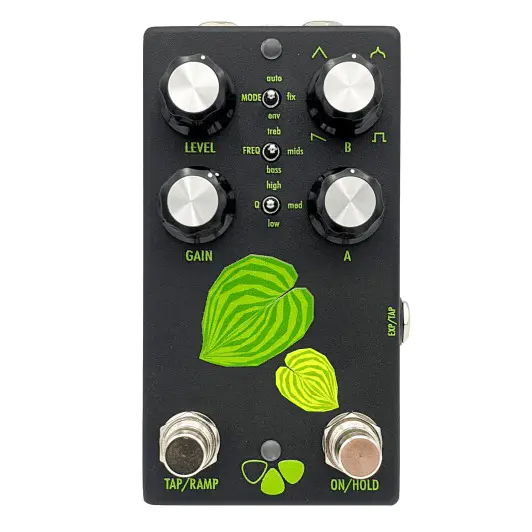
Earlier this year we came to the (in hindsight, rather obvious) realization that synths are more or less 90% just effects. If you take out the oscillators (and whatever’s needed to trigger them), all you are left with is signal manipulation. In subtractive synths (i.e. 95% of the synths on the market) most of this manipulation is just cutting and boosting frequencies, i.e. rather aggressive filters – the wah pedal belongs to that family.
While envelope filters for guitar have been historically associated with funk music, Flower Pedals just unveiled one called Hosta that seems optimized to get some radical/creative sounds, with a renewed focused also on the fixed position filter (something Frank Zappa famously pioneered, by activating a wah without rocking his foot on it)
The Hosa has Three Modes, each controlled by the Tap/Ramp footswitch as well as knobs A and B, which also have secondary functions that can be accessed by holding the On/Hold footswitch.
In Auto mode, the wah is controlled by an LFO. with 4 different shapes and the shape is continuously variable, so you can also get anything in between the 4 shapes. The Tap/Ramp switch can be used for tap tempo (with 4 subdivisions) or ramping. (More info under the videos)
In Fixed mode, the position of the wah filter is chosen by control A, or an expression pedal if one is connected. The Tap/Ramp footswitch can be pressed to move the wah to a second position, as chosen by the secondary parameter of A, and it will move at the speed chosen by control B. (More info under the videos).
In Envelope mode, the wah is controlled by the intensity of the guitar signal, much like an envelope filter. In this mode, control A sets the threshold of the envelope detection and control B sets the sensitivity of the envelope detection circuit. You can then use the Tap/Ramp switch to toggle between filter up and filter down.
Check out the videos!
Have you always wanted a wah planted in your tone garden, but didn’t want to give up the real estate for such a simple effect? Well, check out the Hosta Wah Filter! It’s an analog wah circuit with digital control. The analog circuitry is based off the most well known wah in history, complete with a genuine red fasel inductor.
You are given direct control over 4 parts of the analog wah circuit: Level, Gain, Frequency, and Q. The Level, of course, controls the overall amount of output from the pedal. The Gain controls the gain of the first transistor stage of the filter. The Frequency switch allows you to pick between 3 different center frequencies, with the middle being the standard wah frequency. Q adjusts how tight the peak of the filter is. Choose a high Q for a more quacky sound or a low Q for a less severe filter.
To control the wah, the pedal has 3 different modes: Auto, Fixed, and Envelope. Each of these modes is controlled by the Tap/Ramp footswitch as well as knobs A and B, which also have secondary functions that can be accessed by holding the On/Hold footswitch.
In Auto mode, the wah is controlled by an LFO. A controls the speed and B controls the shape of the LFO. There are 4 different shapes and the shape is continuously variable, so you can also get anything in between the 4 shapes. The Tap/Ramp switch can be used for tap tempo or ramping. The tap tempo has 4 different subdivisions (quarter, dotted eighth, eighth, and triplet eighth) which you can cycle through by holding both footswitches for 3 seconds. By holding the Tap/Ramp switch, you can ramp the speed of the LFO to a different speed and when you release, it will ramp back to the original speed. The speed you ramp to is chosen by the secondary parameter of A, while how fast the ramp happens is chosen by the secondary parameter of B. In this mode you can also use an expression pedal to control the speed of the LFO.
In Fixed mode, the position of the wah filter is chosen by control A, or an expression pedal if one is connected. The Tap/Ramp footswitch can be pressed to move the wah to a second position, as chosen by the secondary parameter of A, and it will move at the speed chosen by control B. Whether the Tap switch latches or momentarily holds the secondary wah position is controlled by the secondary parameter of B (set to the left for non-latching, and to the right for latching). In this way, you can use the Hosta like a traditional wah, but controlled via the tap switch, rather than an expression pedal.
The last mode is Envelope mode, in which the wah is controlled by the intensity of the guitar signal, much like an envelope filter. In this mode, control A sets the threshold of the envelope detection and control B sets the sensitivity of the envelope detection circuit. You can then use the Tap/Ramp switch to toggle between filter up and filter down.
A few more extra features are available. One is the Exp/Tap jack, which allows you to either use an external tap connection to control the Tap/Ramp functions or an expression pedal (signal tip). An internal switch allows you to choose between expression and tap. Note: DO NOT plug in a TS cable for tap if you have the switch in expression mode, as it could damage the pedal. You can also choose whether the pedal defaults to on or off on power up by holding the On footswitch while plugging in power.






















